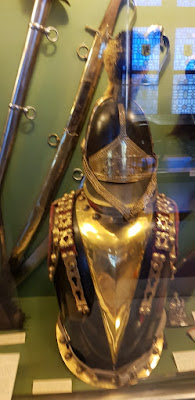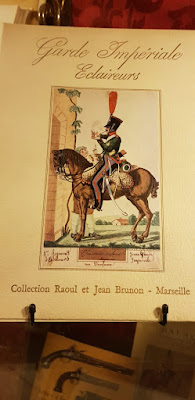Wer an
Museen zur napoleonischen Geschichte denkt, dem fallen unwillkürlich zwei
Städte ein:
Paris und
Waterloo.
Hauptstadt
des Kaisers und Ort seiner finalen Niederlage.
Aber
kennen Sie meine lieben Leser auch die Ortschaft Salon de Provence?
Wenn Sie
bekennender Fan des Kaisers sind, und wenn Sie sich am Ende sogar als
„Napoleoniker“ outen, dann kennen Sie NATÜRLICH den Ort.
Sind Sie
das allerdings nicht, und das dürften 99,5% der Weltbevölkerung sein, dann dürfte
Ihnen das Dorf unbekannt sein, auch wenn dies uns bekennenden Fans des Kaisers
geradezu unmöglich erscheint.
„Welch
Unwissenheit!!!“, höre ich die Eingeweihten rufen
Salon de
Provence liegt, wie der Name der Ortschaft es auch unverhohlen preisgibt,
irgendwo in der Provence, genauer gesagt an der Schnittstelle der A7 und der A
54.
Ich will
jetzt nicht wissen, wie viele Fans des Kaisers da schon vorbei gefahren sind
und nicht gewusst haben, was da vor Ihrer Nase liegt.
Der
deutsche Urlauber, der die A7 von Lyon kommend runter fährt, und der Frankreich
nur passiert –oh diese Parkplätze, oh je diese Stehklos –, um nach Spanien zu
kommen, dem ist das Dorf so was von egal, liegt es doch von hier aus gesehen
schon irgendwo weiter südöstlich von Avignon.
Somit
also „weit weg“ vom Weg nach Spanien.
Der deutsche
Urlauber, der aber bei Lyon abzweigt, und über die A51 Richtung Cote d’Azur
fährt, der biegt dann meistens irgendwo auf die Nationalstraßen ab, oder
spätestens bei Aix-en-Provence nach Osten.
Salon de
Provence liegt aber leider nordwestlich von Aix-en-Provence, also auch „weit
weg“.
Verflucht.
Es
scheint wirklich verhext zu sein.
Liegt
dieses Dorf irgendwo im Nirgendwo, oder wie haben wir das zu verstehen?
Irgendwo
schon, jedenfalls aus deutscher Sicht.
Wenn man
allerdings recherchiert, dann wird man herausbekommen, dass sich in der
Ortschaft eine Burg befindet, deren Grundmauern noch aus dem 9. Jahrhundert
stammen.
In dieser
Burg gibt es dann auch ein Museum.
Es
handelt sich um das Chateau-Musée de L’Empéri.
Dabei
steht das Empéri, nicht für den EMPEREUR. Die hier genannten „Kaiser“ sind
Herrscher des Heiligen Römischen Reiches. Ja die Grenzen des HRR endeten bis
zum 15. Jahrhundert noch auf dem rechten Rhone Ufer.
Wir, wir
Napoleoniker, wollen aber das Empéri natürlich im Zusammenhang mit unserem Empereur
sehen.
Na und
wenn man das Museum in der Burg betritt, denkt man auch unwillkürlich an ihn,
denn irgendwann steht man eben auch vor einem seiner Feldbetten, dass von St.
Helena seinen Weg hierhin gefunden hat.
Ich
selbst habe das Museum noch nie besucht. Meine südlichste Autotour in
Frankreich führte mich bisher nur bis Grenoble. Dann war Schluss.
Eigentlich
wollte ich dieses Jahr mit dem Auto nach Süden. Eigentlich. Dann kam Corona.
Dass ich
das Museum überhaupt kenne, verdanke ich Jens Najewitz, der da schon mehrfach
war, und auf unseren Touren in die Normandie oft davon erzählt hat.
Erst letzten
Sommer war er da wieder unterwegs, na und ich habe ihn dann mal angeschrieben, ob er nicht ein paar
Fotos gemacht hat.
„Klar“,
meinte er, „wenn auch manche verwackelt sind. Ich bin da ja nicht wie Du und
digitalisiere alles!“
Ja, ja so
bin ich.
Aber
irgendwo stellt er sich da auch unter den Scheffel, denn Sie werden mir
sicherlich zustimmen, dass die Bilder aus diesem Bericht hier, dann schon doch
etwas mehr sind als ein Appetizer.
Die
Sammlung war ursprünglich einmal eine Privatsammlung der beiden Brüder Raoul
und Jean Brunon mit 10.0000 Objekten, Dokumenten und Büchern.
Diese
Privatsammlung beschäftigt sich aber nicht nur mit der napoleonischen
Geschichte, sondern mit der Geschichte der französischen Armee von 1700 bis
1918.
Eines der
Highlights, und einige sehen Sie ja in diesem Bericht, sind die 130
lebensgroßen Figurinen. Die Sammlung, bis in den 60er Jahren im Haus der
Brunon’s in Marseille zu finden, wurde im Jahr 1967 vom französischen
Armeemuseum gekauft und dann in das Chateau de L’Emperi transferiert.

Wie Sie
den Bildern entnehmen können, erwartet sie ein klassisches Museum.
Bisschen
wenig Didaktik, aber viel, viel, sehr viel, sehr, sehr viel Material.
Der eine
liebt so etwas, der andere verflucht es.
Egal wie.
Ich finde
es hochinteressant.
Zwei
Räume beschäftigen sich mit französischen Waffen.
Die
Geschichte des Kaiserreichs wird umfangreich in mehreren Räumen ausgestellt.
Zuvor
haben Sie aber schon die Ausstellung der französischen Revolution besucht, wo
Sie dann auch einiges zur Italienarmee und zur Kampagne in Ägypten erfahren
konnten.
Auch die
Sammlung zur Geschichte des Zweiten Kaiserreichs ist beeindruckend.
Krimkrieg
(1854/55), Italienfeldzug (1859), das mexikanische Abenteuer (1862/67) und auch
der Deutsch-Französische Krieg werden vorgestellt.
Bereits
oben habe ich erwähnt, dass aber auch der Erste Weltkrieg thematisiert wird.
Eine
wahrlich umfangreiche Sammlung.
Nachdem
Jens mir jetzt die Bilder hat zukommen lassen, bin ich dann schon leicht
traurig, dass er vermeintlich nicht an mich gedacht hat.
Wäre er
da nicht mit Familienmitgliedern rumgegurkt, sondern alleine, hätte ich ihm
Verrat an dem treuesten Fan des Kaisers vorgeworfen, nämlich an mir.
So, sei
ihm verziehen.
Aber wenn
im nächsten Jahr die Corona Krise hoffentlich überwunden ist, und Du da runter fährst…
ich stehe bereit!!!!
EN
AVANT!!!!!!!!!
When you
think of museums on Napoleonic history, two cities come to mind:
Paris and
Waterloo.
Capital
of the emperor and place of his final defeat.
But do
you, my dear readers, also know the town of Salon de Provence?
If you
are an avowed fan of the Emperor, and if you end up coming out as a
“Napoleonic”, then you OF COURSE know the place.
If you
are not, however, and that is likely to be 99.5% of the world population, then
the village should be unknown to you, even if this seems almost impossible to
us, avowed fans of the Emperor.
“What
ignorance!” I hear the initiates shout.
Salon de
Provence is, as the name of the town openly reveals, somewhere in Provence,
more precisely at the intersection of the A7 and the A54.
I don't
want to know now how many fans of the Emperor have already driven past and
didn't know what was in front of their noses.
The
German holidaymaker who drives down the A7 from Lyon and who only passes France
- oh these parking lots, oh these toilets - to get to Spain, he doesn't care
about the village, it is from here seen somewhere further southeast of Avignon.
So
"far away" from the way to Spain.
The
German holidaymaker, who branches off near Lyon and drives on the A51 in the
direction of Cote d’Azur, then usually turns somewhere onto the national roads,
or at the latest at Aix-en-Provence to the east.
Unfortunately,
Salon de Provence is located northwest of Aix-en-Provence, so it is also
"far away".
Damned.
It really
seems bewitched.
Is this
village somewhere in the middle of nowhere, or how do we have to understand
that?
Somewhere,
at least from a German perspective.
However,
if you do some research, you will find out that there is a castle in the
village, the foundation walls of which date back to the 9th century.
There is
also a museum in this castle.
It is the
Chateau-Musée de L’Empéri.
The
Empéri stands not for L’EMPEREUR. The “emperors” named here are rulers of the
Holy Roman Empire. Yes, the borders of the HRR ended on the right bank of the
Rhone until the 15th century.
We, we
Napoleonics, naturally want to see the Empéri in connection with our Empereur.
Well, and
when you enter the museum in the castle, you think of him involuntarily,
because at some point you stand in front of one of his camp beds that found its
way from St. Helena here to this place.
I have
never visited the museum myself.
My
southernmost car tour in France has only taken me to Grenoble so far.
I
actually wanted to drive south this year. Actually. Then came Corona.
I owe my
knowledge of the museum to Jens Najewitz, who has been there several times and
often told us about it on our tours to Normandy.
Only last
summer he was there again, well and I wrote to him once if he hadn't taken a
few photos.
“Sure,”
he said, “even if some are shaky. I'm not like you and digitize everything!
"
Yes, yes,
that's me.
But Jens,
don’t be so humble, because you my Dear Reader will surely agree with me that
the pictures from this report here are a bit more than an appetizer.
The
collection was originally a private collection of the two brothers Raoul and
Jean Brunon with 10,000 objects, documents and books.
This
private collection is not only concerned with Napoleonic history, but also with
the history of the French army from 1700 to 1918.
One of
the highlights, and you can see some of them in this report, are the 130
life-size figurines.
The
collection, to be found in the Brunon’s house in Marseille until the 1960s, was
bought by the French Army Museum in 1967 and then transferred to the Chateau de
L’Emperi.
As you
can see from the pictures, a classic museum awaits you.
Little
didactics, but a lot, a lot, a lot of material.
One loves
it, the other curses it.
No matter
how.
I find it
very interesting.
Two rooms
deal with French weapons.
The
history of the empire is extensively exhibited in several rooms.
Before
that, however, you had already visited the exhibition on the French Revolution,
where you learned a lot about the Italian Army and the campaign in Egypt.
The
collection on the history of the Second Empire is also impressive.
The
Crimean War (1854/55), the Italian campaign (1859), the Mexican adventure
(1862/67) and the Franco-German War are presented.
I already
mentioned above that the First World War is also an issue.
A truly
extensive collection.
Now that
Jens has sent me the pictures, I'm a little sad that he supposedly didn't think
of me.
Had he
not been messing around with family members, but alone, I would have accused
him of betraying the emperor's most loyal fan, namely me.
So, be
forgiven him.
But when
the Corona crisis is hopefully history next year and if you go down there Jens,
just hear my cry ... I'll be ready !!!!
EN AVANT
!!!!!!!!!















































































































































Keine Kommentare:
Kommentar veröffentlichen